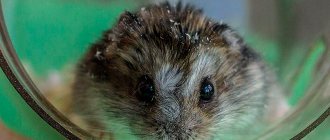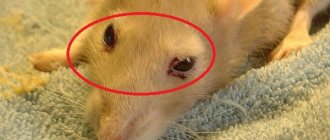Often, when choosing a hamster, people try to find out all the nuances about its health, maintenance, care, etc. This is the right tactic, because it is better to immediately know what we will face in the future. In markets and pet stores you can find a wide variety of breeds of hamsters.
There are both small Djungarians and long-haired Syrians. Occasionally you may see a white hamster with red eyes. Usually such animals scare people and they pass by. After all, such an appearance is associated with congenital pathologies, weakness, and diseases. However, you should not judge a hamster just by its appearance.
In fact, even a hamster with red eyes can be completely healthy and capable of producing good offspring. It is only important to learn how to determine what causes the strange coloring. Below we will help you determine why your hamster has red, although otherwise completely normal, eyes. This may depend on several factors.
Among them, the most common are tiny Djungarian and long-haired Syrian hamsters. A white hamster with red eyes is less attractive and even frightening to humans. This appearance gives rise to false assumptions about the disease and pathologies of the animal. But here it is important not to rush to conclusions and figure out why the hamster has red eyes.
Most often, the red-eyed hamster is absolutely healthy and ready to give the same strong offspring. The main thing is the ability to determine what contributed to such an unusual color. Below it will become clear exactly how to do this and you can easily figure out on your own why the hamster has red eyes. There are no other oddities in these eyes, only the color. So, there are several factors that influence color.
Albinos
Why do hamsters have red eyes? It happens that the most ordinary hamster parents give birth to a baby whose fur does not even have a hint of pigmentation. No type of color suits him. It is for such special animals that the name albino was created. Every species of rodent sooner or later encounters such unusual representatives. Albinos are also found among most creatures on Earth.
Such fluffies are considered very valuable, since genes are responsible for the presence of pigment, but its absence is a random and natural result. These little ones have red or pinkish eyes. In nature, such rodents have a hard time, since their white fur gives them away in a dangerous situation, so they do not live long. Well, in a cozy human house, hamsters feel calm and confident. The lifespan of pets is 3-4 years.
The health of albinos is quite fragile, which is worth remembering. The color of the coat and eyes are not the only differences from relatives; habits, character and size may also vary slightly.
Breed and features
The international organization allows several colors, when red eyes in hamsters are considered the norm. Among them are white and ivory hamster. They are quite similar to each other, but they contrast sharply with others.
There will be no spots or other darker inclusions on the fur, only white. This makes the red eyes and pink ears stand out even more. It would seem that this baby is no different from his albino relative, but his breed has not undergone mutational changes and is considered absolutely healthy.
Non-communicable diseases
Non-contagious diseases of Djungarian and other breeds of hamsters primarily include injuries. They are injured mainly due to the fault of their owners. Rodents should not be allowed to walk on a table or other surface from which the homa could fall. When purchasing and installing a running wheel, it is necessary to exclude narrow (less than 0.5 cm) gaps so that the baby does not stick his paw in there and injure himself. If you have several dwarfs, place them in different cages. Otherwise, they will fight and may also injure each other.
Poor nutrition may be the cause
- dental diseases;
- inflammation of the cheek pouches;
- food poisoning;
- hemorrhoids (if blood drips from the anus, your pet may have a fissure there).
Non-communicable diseases also include complications of pregnancy and pathological childbirth in females. Sometimes blood under the female's tail appears as a result of a miscarriage.
Bacterial infections
If you notice that your hamster's eyes are festering, it means that your pet has picked up a bacterial infection. Its common pathogens are spherical and rod-shaped bacteria: staphylococcus, clostridium, E. coli, streptococcus, etc. Once under the eyelid, they begin to actively multiply. To fight them, the body sends protective cells - leukocytes, various enzymes and other substances that destroy the bacterial wall. As a result, pus is formed - a viscous substance containing living and dead bacteria.
There are several bacterial eye diseases. If your hamster's eye is festering, it could be one of the infections discussed below.
Conjunctivitis
The disease is not dangerous if left untreated. The disease in most cases is caused by pathogenic microflora and only occasionally has an allergic origin. First, the animal’s eyes begin to water; at this stage, few are able to recognize the disease. Then more reliable symptoms appear:
- The hamster's eye is rotting. Pus is a yellow or greenish mass that collects in the corners of the eye;
- the eyelids become inflamed and may swell;
- the palpebral slits narrow until the eye closes completely;
- the animal becomes apathetic and may lose appetite.
If a hamster's eyes fester, it is important to start treatment on time, since pathogenic flora can spread to the eyelids from the inside and outside, the hair will begin to come out, and the pet will be very uncomfortable. As a result of advanced conjunctivitis, the eyes may close completely, and this is a huge stress for the animal.
Few people know how to treat conjunctivitis in domestic rodents and whether it is possible to use a human first aid kit. Of course, it is better to make an appointment with your veterinarian to get professional advice. But if this is not possible, you will have to care for the fluffy yourself.
Doctors do not recommend smearing the eyes of rodents with tetracycline ointment. It is better to use Albucid drops, drip them three times a day. Treatment of hamsters, depending on the degree of neglect of conjunctivitis, will last from 3 days to 2 weeks.
Important points in treatment and prevention:
- A sick hamster should be isolated from healthy individuals if you have several rodents.
- Every eye of the animal is treated, even if suppuration is noticed in only one. This is done so that the animal does not transfer the infection from one eye to the other while washing.
- During conjunctivitis, it is better to change the litter daily.
- Eliminate sweets from the diet for a while, give only grains, nuts and unsweetened vegetables.
- To reduce the chance of eye infection, clean the cage frequently. Also make sure that children play with the hamster after washing their hands first.
Conjunctivitis cannot be left untreated; this will lead to the eye not opening at all, or, on the contrary, it may “pop out.”
Blepharitis
Usually a complication of conjunctivitis, with inflammation spreading to the eyelids. They turn red and itch terribly, the hamster rubs its eyes, which is why the hair quickly falls out. If you bring your pet with these symptoms to the veterinarian, he will tell you in detail why the hamster's eye is swollen. The doctor will tell you how to properly treat blepharitis.
Usually, in case of purulent inflammation of the eyelids, the same eye drops are prescribed as for conjunctivitis. In addition, it is recommended to smear the animal’s eyelids with tetracycline ointment. Sanitation and diet are also similar to those for conjunctivitis.
bulging eye
It happens that one eye of a homa becomes larger than the other and seems to stick out a little. If a hamster's eye pops out, this is a consequence of injury (for example, falling from a height) or an advanced infection. Conjunctivitis can spread not only to the eyelids. Bacteria can penetrate into or under the eyeball. There they begin to divide, a lot of pus is formed, which seems to squeeze the eye out.
The situation is very serious, you will not be able to cope with it on your own. The prognosis is also disappointing: in most cases, the animal is prescribed surgery to remove the organ of vision.
“False” eye diseases
Sometimes the reason why a hamster's eyes won't open is due to other illnesses. For example, a severe inflammatory process in one of the cheek pouches. Because of this, the animal's cheek swells and props up the lower eyelid. As a result, the hamster is unable to fully open its eyes.
To help the animal, you should take it to the veterinarian for a cheek cleaning procedure. Eye drops and ointments are not needed at all.
The main condition for maintaining the health of your pet's eyes is cleanliness. Wash the cage often and do not touch the animal with dirty hands. But if your pet has an inflamed eye, treat it with special drops. Do not forget to isolate the sick rodent from a common cage if you have several hamsters, because eye diseases are very contagious.
Other diseases in hamsters that may cause eye problems
Eye infections are not always the reason why a hamster’s eyes are watery or other problems with the organs of vision have appeared. Sometimes the problems are completely different, and eye discomfort is just a side effect.
For example, inflammatory processes in the cheek pouches. In this case, the cheek may become swollen and, as a result, the hamster's eye closes. In this case, there is no need to put drops in your eyes or smear them with ointment, it will not be effective. The cheeks should be cleaned; this should only be done by a veterinarian.
Another common problem is an abscess in the hamster as a result of a strong blow, bites from other rodents and the like. For example, a bump or swelling in the head area, if the blow lands there, can cause redness of the eyes.
It’s great if you notice swelling in the initial stages, in which case you can get by with taking antibiotics, but if this moment was missed, a purulent wound may develop. This problem requires more serious treatment, often surgical intervention.
Under no circumstances should you self-prescribe medications to an animal. Sometimes rodents may not tolerate certain medications, this will lead to fatal consequences.
Only after a complete examination of the animal can the veterinarian correctly prescribe treatment. Sometimes, it may be necessary to open and wash the wound, install drainage, and apply sutures. Sometimes the abscess opens on its own, then the doctor performs a slightly different series of manipulations, which also include washing and disinfecting the diseased area of the body.
Injuries and inflammatory processes and their symptoms
In inflammatory processes associated with pathologies or injuries, the following symptoms occur:
- edema;
- inability to open eyes, squinting, trembling eyelids;
- liquid or purulent discharge, tearing;
- formation of a cone or barley;
- redness of the damaged area;
- hair loss on the eyelids and around the eyes.
The presence of these manifestations indicates infectious or age-related pathologies, and sometimes mechanical damage. In the latter case, infection with pathogens may occur later if the animal was not treated in time or the pet’s immune system is weakened.
When infected, the general condition further worsens. The pet refuses water and food, vomits, and digestion of food is disrupted.
Corneal damage
Damage to the cornea occurs more often in mobile, active animals. In most cases, the condition is associated with mechanical trauma.
Corneal damage often occurs due to mechanical trauma.
Shards, dust, sand, filler, etc. can get into your eyes. Sometimes the damage is caused by a scratch. In rare cases, the integrity of the cornea is compromised due to infectious pathologies, contact with chemicals and congenital pathologies.
If the pet's cornea is damaged, visual acuity decreases. The problematic eye is closed or squinted, the eyelids tremble. Sensitivity to irritants is increased: the pet hides in a bright room and suffers from severe lacrimation. The general well-being of the animal worsens. The mucous membranes turn red.
If damage to the cornea is associated with a foreign object, there is a chance that the latter will be removed without third-party intervention along with the discharge. Otherwise, you need to visit a veterinarian. After removing foreign bodies, the eyelids are washed with antibacterial agents and anti-inflammatory drugs are used.
Blepharitis
Blepharitis is an inflammatory process that primarily affects the eyelid rather than the eye. However, these are neighboring tissues, so as the disease develops, the organs of vision also suffer. Blepharitis develops due to many reasons. For example, due to bacterial infections, incorrect use of medications, inflammatory dermatological pathologies, gastrointestinal problems, etc.
Blepharitis is accompanied by purulent inflammation of the eyelids.
Blepharitis is characterized by changes in the color of the eyelids. They may darken, but more often they turn red due to inflammation. Sometimes the skin on them peels off. The animal suffers from itching. It scratches your eyes and can damage them. Another problem is weakening of local immunity and possible infection. Bumps often form on inflamed eyelids.
Blepharitis of the eye is usually treated with antibiotics. Additionally, it is important to maintain cleanliness in the cage and provide your pet with time. This will prevent the progression of the disease and infection of the tissues.
Abscess
Another name for an abscess is stye. This is not an independent disease, but a symptom. It can occur against the background of blepharitis, weakened immunity with concomitant infection, etc. When an abscess appears, the appearance of the eye changes, and a difference in size becomes visible due to the tumor. The temperature of neighboring tissues rises as a result of inflammation.
With an abscess, itching occurs, and sometimes mucous discharge appears. In rare cases, barley goes away on its own, but more often it requires veterinary intervention. Recovery occurs after the capsule is freed from pus.
Blunt trauma
A rodent can receive blunt trauma as a result of a fall. Sometimes an animal is accidentally crushed while walking. As a result, massive damage to all structures of the visual organs occurs. It is accompanied by severe hemorrhage. In case of injury, only 1 eye or both may be affected. A few hours after the injury occurs, the blood settles and the tissues turn red. The entry of blood particles into the vitreous body causes vision loss.
In case of injury, damage to one eye is typical.
If a blunt injury occurs, the animal should be taken to a veterinarian as quickly as possible. It is impossible to make a prognosis and cure your pet at home on your own. You can only provide first aid if you cannot visit the clinic in the near future. Apply a cool cloth soaked in saline solution to the damaged area and use antibacterial ointment. The latter prevents the cornea from drying out in case of severe swelling, if the animal cannot blink.
Conjunctivitis
Conjunctivitis is the most common eye disease found in hamsters. The pathology is characterized by bilateral inflammation, although this is an optional sign. The disease develops due to mechanical trauma, irritation from chemicals, infections, allergies, etc. The animal can become ill when in contact with household products, such as floor cleaning solution or hairspray. Filler, dust or sand can provoke inflammation. Poor quality litter injures mucous membranes.
With conjunctivitis, the animal's eyes begin to water.
Symptoms help indirectly determine the cause. In the initial stages, if the disease is caused by mechanical irritation or allergies, the discharge from the eyes will be clear. If there is an infection, the liquid becomes cloudy and later acquires a yellow or greenish tint. The animal can become infected with pathogens during the process if it is not given timely assistance.
Other symptoms include itching, pain, photophobia and watery eyes. The eyeball enlarges, the eyelids swell. To eliminate symptoms, anti-inflammatory and antibacterial agents are used.
Bacterial infections
Bacterial infection can be either an independent or concomitant disease. Most often, conjunctivitis develops as a result of the penetration of pathogens. An animal can become infected if it has a weakened immune system, is injured, has a damaged cornea, etc.
Bacteria multiply quickly, especially if the damage is deep. Without help, pathogens increasingly penetrate tissues. Subsequently, the bacteria, along with the bloodstream, are spread to all organs and systems, which can lead to the death of the animal. In case of deep infection, it is necessary to resort to surgical intervention, including removal of the eye, in order to save the hamster’s life.
Prevention of eye diseases
As you know, a disease is always easier to prevent than to treat.
By following some simple recommendations, you can reduce the risk of eye diseases in your pet to a minimum:
- Use a material for bedding that will not cause mechanical damage to the eyes and in which bacteria will not accumulate. Pet stores sell special litters; you can use odorless cat litter or wood litter.
- You should not keep many hamsters in one cage, as this can be dangerous.
- Separate from the rest of the hamsters those who have congenital diseases or are genetically predisposed to them.
- Do not place the cage in direct sunlight.
- Examine your pet's eyes regularly for signs of injury.
- Try to minimize or completely eliminate sweets from your diet.
Classification of diseases
According to the type, hamster diseases, like those in humans, are divided into contagious and non-contagious. The following diseases are contagious.
- Bacterial infections. Cause gastrointestinal, skin and other inflammatory processes.
- Viral infections. They affect the eyes and mucous membranes and cause tumors.
- Fungal. Mainly they cause skin diseases.
- Infection with parasites (fleas, ticks, worms).
Some of these diseases can be transmitted to people. You need to be extremely careful when contacting a sick animal and take it to a veterinarian as quickly as possible. Only a doctor, after performing tests, will make a final diagnosis and give a prognosis for the possibility of recovery. Unfortunately, many diseases are fatal to a hamster. But in any case, a loving owner will do everything in his power to ensure that the hamster recovers.
Non-communicable diseases include non-communicable diseases.
- Injuries and bruises caused by falling from a height or fighting with other cage occupants.
- Metabolic disease. For example, diabetes mellitus, which most often affects Djungarian hamsters.
- Diseases caused by stressful situations. These include heart disease, heart attacks, and strokes.
Diseases in Syrian hamsters are most often associated with gastrointestinal infections.
Treatment of disease in Djungarian hamsters
By contacting the Ya-Vet veterinary center, we will provide you with full qualified assistance, help you console yourself and cure your rodent, and you can also use the service of calling a doctor at home. The experience and professionalism of our specialists will satisfy all your requirements, and the price will pleasantly surprise you.
After a complete examination, the veterinarian may prescribe home treatment . Let's look together at what a hamster owner can handle on his own.
- If you have a cold , it is enough to give your hamster more fruits that contain vitamins; they, in turn, will stimulate the functioning of the animal’s immune system. Thus, with a minor cold, your hamster will return to normal in a couple of days.
- In case of eye disease, it is enough for the rodent owner to rinse the eyes with lightly salted water several times a day.
- In case of mechanical damage to the teeth or their shortening, you should contact veterinary centers for qualified help; in many cases, the diagnosis and its solution can only be made by a highly specialized specialist.
- Diseases of the skin and coat are varied; hair loss can be triggered by a state of shock, fear of the baby, or prolonged stress, pay attention to this. There may also be parasites on the skin of the animal - ticks and lice; special sprays and ointments will help us deal with this problem.
- For disorders of the gastrointestinal tract of the Djungarian hamster. It is enough to change his diet, pay attention to the foods he eats.
- If tumors and lumps , immediately contact a veterinary center, only there they will give you an accurate diagnosis and offer the right path to solving the problem.
- Constipation is treated by adding a drop of vegetable oil to the food; it softens the solid mixture and forms a soft effect on the walls of the stomach. Also, the addition of fiber (fruits, vegetables) will accompany you on the way to a good passage of the intestinal tract.
- Allergies in a hamster can be caused by unsuitable food, sawdust in the cage, or bedding materials.
- Molting is treated by normalizing nutrition, including vitamin-rich foods in the diet and adding yeast to the water.
- If you have an obese hamster , then treatment is completely in your hands; the right diet and exercise will get your pet in shape.
Albino diet
Your pet's diet needs to be balanced so that it includes proteins of both plant and animal origin. If you try, you can find specialized food in pet stores at an affordable price. Several times a week, hamsters are allowed to be given foods such as eggs, parts of worms, chicken meat and boiled lean fish. Products such as preservatives and unnatural dyes are prohibited in the diet of hamsters of any breed.
In addition to the above, the following items must be absent:
- sweet, salty, smoked and pickled;
- almonds, watermelons, exotic fruits;
- honey and sorrel;
- peas;
- corn seeds;
- sunflower and pumpkin;
- any nuts except almonds. It can be kept to a minimum;
- cabbage and beets. The exception is white cabbage;
- pears, carrots and apples;
- Dried fruits are acceptable in the winter as a top dressing.
Before treating your hamster to fresh types of fruit, it is recommended to remove all the seeds from them. The acid contained in the seeds can be poisonous to the animal.
Hamsters need to be fed 2 times a day. Albinos should not have foods such as spicy, sweet or salty foods in their diet. When feeding an animal for a better diet, wet and dry food, if it is not a mixture, is recommended to be added to different bowls.
Many novice owners ask about the size of food portions, which should be determined individually. Given their living conditions in nature, hamsters can be content with a deficient amount of moisture, replenishing it from fruits and vegetables, as well as wet food. Every day you need to replenish your supply of greens, lettuce leaves and cucumbers.
Differences in appearance
The Djungarian hamster and the Campbell's are very similar. They have approximately the same weight and size and can mate with each other, so it is likely that a pet store may sell hybrids that have characteristics of both species. But still, each type has its own differences.
By coat type and color
The greatest differences between these types of hamsters are external.
Distinctive features of dzhungariks:
- White belly and arches on the sides, which are called vaults.
- There is no pattern on the fur other than its natural one.
- Smooth dense fur.
- But on the head there is a darkening of the fur in the form of a diamond. There are also dark spots on the sides.
- The base of the hair on the abdomen is white.
Did you know? Hamsters are one of the few animals that already have teeth at birth. Rodents' teeth grow throughout their lives, so the animal must constantly grind them down. Based on color, Djungarian hamsters are divided into :
- brown-gray with white belly (standard);
- white-gray (pearl);
- gray-blue with a white belly (sapphire);
- red-cream (mandarin).
Two types of hamsters have a dark stripe on their back, but in the Djungarian it is wider. Winter molting is also typical for animals of this species. This process depends on the length of daylight hours. As soon as the days become short, over the course of 6 weeks the dzhungarik changes color to almost white. This is due to the production of the hormone melatonin.
Did you know? Male Campbell's hamsters help females during childbirth: they remove the cubs, clean the newborn's nostrils, and carry them to the nest. If the female leaves the nest, they remain to look after the offspring.
Distinctive features of Campbell's hamsters:
- Some individuals of this species also have arches, but they are not as clearly defined as those of the Dzungarians.
- The fur is more protruding because it grows at a greater angle to the body.
- The color is mainly red, but they can be of various colors: from white to black. In nature, the coat color is dark gray with brown areas.
- On the back the dark stripe is narrower, but more clearly defined. There is no darkened diamond on the sides and head.
- The base of the hair on the abdomen is gray.
- Does not change coat color for the winter.
Dimensions
The size of individuals of the two species is the same - 7–10 cm in length, the weight of an adult rodent is 60–70 g. Since the size of the animal is small, it can live in a small cage or a small aquarium.
Body type
The Djungarian hamster is shaped like an egg. The line of his head flows smoothly into his nose. Campbell's hamster's body is shaped like a figure eight. That is, this species has a pronounced waist. Their nose looks like a small bump. An animal of this species has smaller ears.
Did you know? Campbell's hamsters were named after a member of the British consular service in China, Charles William Campbell.
Eye color
The eye color of hamsters is mostly black. But it is possible to meet healthy animals with red and ruby eyes. These are mainly white and ivory rodents. An animal inherits eye color depending on dominant or recessive alleles. Sometimes an ordinary couple gives birth to a completely white baby with red eyes. This is an albino. For rodent breeders, such a specimen is very valuable, since the absence of the melanin pigment is not transmitted by genes, but is obtained by chance.
Why the hamster...?
There are several reasons why rodents refuse to eat: 1. Clogged or inflamed cheek pouches, dental problems. 2. Poisoning. 3. Infectious diseases affecting intestinal function. Your actions: Examine the hamster yourself, pay attention to its droppings, change its diet, show it to a specialist. — Why does a hamster have yellow teeth? The tooth enamel of hamsters is not white, like that of humans, but yellowish. If the teeth are completely yellow, this may indicate that the animal is old or that the food the hamster eats contains dyes. — Why do the hamster have red eyes? This is a type of mutation that most often occurs in rodents with white and light fur. This is normal and does not require treatment.
Why the hamster...? Djungarian hamster Acrobatic. Vl. Krivosheev Alexander - Why does the hamster sleep all the time? Hamsters are nocturnal rodents, so they sleep almost all day. Sleep norm is 15-18 hours; if the hamster sleeps more, consult a doctor. — Why doesn’t the hamster drink water? If the hamster receives enough succulent food (fruits or vegetables), then it usually does not need water. But no matter what the hamster eats, there should always be fresh, clean water in the cage. — Why does a hamster squeak in its sleep? The squeaking may be from pain, or it may simply be uncontrollable sounds (not dangerous). Your actions: If the squeak is repeated constantly, then it is better to show the hamster to a doctor. — Why does a hamster eat its babies? There are several reasons for this: 1. Natural selection (cubs with various developmental defects, i.e. not viable offspring). 2. Lack of protein in the diet. 3. Young female (weak maternal instinct). 4. The mother and cubs are often disturbed (they pick up the cubs, look into the house, change the bedding ahead of time, etc.). Your actions: 1. Select a male more carefully (from another litter, not a close relative). 2. Increase the amount of protein in your diet. 3. Avoid getting pregnant too early. 4. Do not disturb the mother and her cubs. The bedding is changed on the 7-10th day of the cubs' life (you will have to endure the unpleasant smell). — Why do hamsters run in a wheel? Hamsters run on a wheel because they need movement and sometimes a cage alone is not enough for them. The wheel must be at least 18 cm in size and is intended specifically for hamsters. - Why do hamsters stink (smell)? An unpleasant odor can come from both the hamster and the bedding. If your hamster's urine starts to smell very strongly, then most likely he has kidney problems or a bacterial disease. An unpleasant odor can come from spoiled hamster food. Bad breath may be due to clogged or inflamed cheek pouches. Your actions: 1. Change the filler. 2. Change food. 3. In other situations, an examination by a specialist is necessary. - Why do hamsters fight? In nature, hamsters live alone. When two hamsters meet, a fight may occur, as the rodents defend their territory. If you introduce a newbie to a hamster, then a fight in such a situation is inevitable, because... the old-timer will defend his territory (cell) from the newcomer. If hamsters are left in a cage, sooner or later, the stronger one will bite the weaker one. Keeping several individuals (especially of the same sex) together in one cage is undesirable. — Why do hamsters bite? Hamsters can bite out of fear, as well as in defense. Imagine yourself in the place of a hamster. Without your consent, the giant roughly grabs you and begins to squeeze you. You'll like it? The same thing happens with a hamster. He squeaks and defends himself as best he can. Your actions: The hamster should be tamed gradually. Some individuals are not tamed immediately. Every animal has its own individual character. It may also be that your hamster will remain wild, no matter how hard they try to tame it. - Why can’t a hamster have cabbage? Hamsters should not be given cabbage due to the enzymes it contains. When cabbage is digested, an increased amount of gases is released in the intestines, which causes bloating and intestinal obstruction in the hamster. If bloated, give your hamster a couple of drops of dill water (sold in pharmacies for babies) or a decoction of dill seeds.
>Why do hamsters have red eyes?
Eye care for hamsters
There are rules that, if followed, will help owners minimize the risk of ophthalmic problems in hamsters. These include:
- regular inspection of animals;
- immediately contact a veterinarian if eye pathology is detected;
- trimming the hair around the eyes of representatives of long-haired breeds of hamsters;
- use of high quality bedding material;
- regular change of litter as it gets dirty;
- timely treatment of infectious diseases.
It is very important not to leave the hamster's cage in direct sunlight, as this can also lead to blindness. If the animal has the opportunity to walk freely around the apartment, then you should ensure that there are no drafts and that surfaces are clean, even in hard-to-reach places.
Conjunctivitis in hamsters: symptoms and treatment methods
Conjunctivitis is a familiar problem to everyone, but it affects not only people, but also pets. It needs to be treated at the first symptoms, because in a neglected state many more serious sores can be added, some of which can only be solved by surgical intervention.
The first symptom of conjunctivitis is considered to be wet eyes, then more serious troubles are added, such as:
- The hamster's eyes fester, the pus is characteristically green or yellow, especially in large quantities in the morning;
- The eyelids swell;
- The animal cannot fully open its eyes;
- The hamster becomes lethargic and refuses to eat.
Usually, for conjunctivitis, the veterinarian prescribes washing and instillation of the eyes with special drops. Also, a sick animal needs to be subject to some kind of quarantine. Isolate him from other animals that live in your home.
Additional tips regarding treating conjunctivitis in hamsters:
- Careful hygiene. Change the bedding daily, and wash your hands before putting drops in the animal’s eyes;
- Both eyes need to be treated, even if only one is sick;
- Monitor your pet's diet, excluding sweets;
Usually, conjunctivitis can be completely cured in two to three weeks. To avoid re-infection, try to keep the animal's cage clean and play with it after washing your hands.
It is important to know that untimely treatment of this infection can lead to your hamster's eye popping out. It will become unnaturally convex. This can only be corrected through surgery.
Rules for caring for albino hamsters
Caring for snow-white hamsters is almost no different from caring for other rodents. But there are several features in their content that should be taken into account so that the pet feels calm and comfortable:
- Animals with white coats do not like to be close to other hamsters, so it is advisable to keep them in a separate cage. This is especially true for miniature albino jungarians, who often show aggression towards other rodents;
- The owner will have to frequently change the bedding in the pet’s home to prevent infection from entering the animal’s sensitive eyes;
- Cage size is also important when keeping these unusual animals. The cage should be spacious and equipped with a running wheel, shelves at different levels and a swing;
- Snow-white rodents love secluded places where they can hide from everyone. For example, the albino Syrian hamster needs a house in which it spends most of the daytime, escaping the light and sun;
- Hamsters with snow-white fur should not be bathed. To make their coat look well-groomed, just put a bath with special sand in the cage;
- These animals are very shy, so it is necessary to protect them from noise and loud sounds. It doesn’t matter what breed your pet is, a miniature Djungarian hamster, or a fluffy snow-white Syrian, the main thing is to devote enough time and attention to your unusual pet, because each of them needs the love and care of the owner.
Albino hamsters: a separate breed or not?
The opinion that hamsters with a snow-white coat and red eyes belong to a separate breed is erroneous. After all, albinos are found both among the Dzungarians and among representatives of the Syrian breed.
It is quite difficult to meet albino hamsters in natural habitats, since due to their light fur the animals are not adapted to survival and often become victims of predators.
To breed rodents with a white color, it took breeders several years of hard work, and such experiments did not always end successfully. The first white hamsters, bred artificially, were not distinguished by good health and long life expectancy. In addition, albinos behaved aggressively and often bit their owners when trying to pick them up.
Finally, after lengthy selection work, scientists managed to breed white hamsters that did not have serious health problems and had a friendly, peaceful character.
Miniature rodents with a dazzling snow-white coat and bright red eyes are quite rare even now, so they are especially valued by breeders and are popular among fans of unusual pets.
Causes of red spots around the eyes
Sometimes it happens that it is not the eyes themselves that become red and swollen, but only the skin around them. What are the causes of red spots around the eyes? In many ways, predisposing factors are in one way or another associated with other ophthalmological diseases:
- Very often, redness of the skin is explained by the irritating effect of the inflammatory exudate that flows from the eyes during conjunctivitis.
- In addition, many eye pathologies are characterized by severe itching and other unpleasant sensations, due to which the animal constantly rubs its eyelids and the skin around them with its paws. Simply put, redness is a consequence of rubbing and scratching.
Tumors and neoplasms
Tumors (malignant, benign), pathological growths on the body, legs. ears is a fairly commonly diagnosed pathology in rodents, which can develop for a variety of reasons. Bumps can appear due to injuries, severe bruises, or falls from a height. To begin treatment, you need to establish a diagnosis, so take your pet to a veterinarian.
For benign and malignant tumors, surgical treatment will be prescribed. If the cancer is localized in a hard-to-reach area (oral cavity), the tumor has metastasized, veterinarians recommend euthanizing the patient.
Non-inflammatory diseases
Non-inflammatory diseases include cataracts, cataracts, glaucoma and oncological pathologies. Some of them are related to genetics or age-related changes. In general, such pathologies progress more slowly, making it more difficult for owners to notice the symptoms.
Belmo
A cataract is characterized by the appearance of a white spot on the surface of the eye. The cause of the disease is trauma, and less commonly, cataracts. With massive damage, the stain can cover the entire surface. If some of the mucous membranes turn white, you need to contact a veterinarian. This will help distinguish the eyesore from other pathologies. The disease has no cure, but does not threaten the life of the hamster. The animal's vision may deteriorate.
An eyesore is caused by injury or cataracts.
Cataract
Cataracts in a hamster develop due to a metabolic failure in the lens. If the disease progresses, it leads to blindness. It is assumed that the pathology develops due to injuries, old age, frequent stress, etc.
Cataracts in rodents cannot be treated. Surgical intervention is not used for pathology, and eye drops are ineffective. The disease is easier to prevent than to cure. To do this, the pet is fed plant foods rich in retinol, is not given sweets, vision pathologies are promptly eliminated, and the cage is not placed in the sun.
Glaucoma
Glaucoma is characterized by increased eye pressure. Because of it, the tissues increase in size and begin to bulge. The pet is in pain. Without help, the eyes fall out or leak. The only thing a veterinarian can do in this case is to perform enucleation. The animal will lose vision, but the procedure will prevent infection and relieve pain.
Glaucoma causes increased intraocular pressure and is accompanied by bulging of the eyeballs.
Oncological diseases
A lump in the eye area may not be blepharitis, but a malignant tumor. There is no generally accepted effective treatment in this case, but you can try to save your pet. To do this, they turn to a ratologist to remove the tumor, after the operation they use antibiotics, drugs to strengthen the immune system and vitamins. Even if the treatment does not save the animal, it will improve its condition.
Life expectancy of albinos
The white hamster with red eyes is found in every breed of rodent. Hence the different life expectancies of albinos.
- Djungarian hamsters live for about two to three years. Some individuals live for four years.
- The lifespan of a Syrian is three years. There are rodents that live up to six years.
- Campbell's species rarely lives for more than two years.
- The lifespan of a Roborovsky hamster is two and a half years.
- The shaggy dwarf rodent rarely lives more than two years.
The lifespan of a snow-white animal depends not only on the breed, but also on the conditions of detention, nutrition and care. If you feed your pet high-quality food, show it to the veterinarian on time, and keep the cage clean, then its life expectancy increases.
Why do hamsters have red eyes? A few simple answers to your question
The most common are the cute Djungarian and Syrian hamsters with long hair.
Therefore, the red eyes of a hamster become quite unusual and repulsive for us. Some people who are not familiar with the distinctive features of the breed mistakenly assume that a hamster with red eyes has some kind of pathology and is sick. Don't rush to conclusions, you just need to figure it out. Such animals are capable and produce healthy offspring. The main thing is to determine the cause of the rodent’s unusual eye color.
Albino hamsters with red eyes
The “classics” are albino hamsters with red eyes. In their case, the red color of the cornea is absolutely normal and does not pose any danger to the health of the animal. This color is due to the fact that blood vessels are visible through the pigment-less cornea.
It is generally accepted that animals with red eyes are necessarily blind from birth, but this is not at all true. In most cases, “red eyes” do not have problems with vision. Moreover, blindness is weakly associated with eye color. If blind animals regularly appear in the litter of animals, then such producers should be excluded from the reproduction process due to the presence of some defective genes.
Breed characteristics
You need to start with one simple fact: red eyes in hamsters do not in all cases indicate an illness in the animals.
Moreover, many breeds of rodents have such eyes initially (more precisely, this is a consequence of selection work). In these cases, “redness” is just breed characteristics:
- Campbell's hamsters. Not all of them, but only some color varieties (light, including sandy and amber).
- Many other hamsters with gray, brown, white coloring, as well as in the “ivory” variants, have red eyes.
There are exceptions too. For example, among “jungarians” this coloring of the cornea is not found at all, with the exception of albinos. However, it is impossible to describe all possible breed variations within one article. If there are doubts related to the coat color and eye color of the animal, consultation with an experienced breeder is necessary.
In particular, there is a classic situation when the same Campbell hamsters are passed off as Djungarian hamsters. So, if in the first case animals have red eyes and this is allowed by breed standards, then in principle Djungarians cannot have red eyes.
List of necessary things for an animal
For a comfortable life for an albino hamster, the necessary minimum of things must be present in its cage, namely:
- Bedding, which can be simple sawdust. The hamster will be able to move around somewhat, in addition, they are safe for health;
- The hamster needs a house as a personal space where he can retire and hide from the light;
- In order to wean your pet from using the toilet in a cage, you need to place a special container that can be easily purchased at a pet store;
- Mineral stones will help your rodent grind his teeth easily. For such purposes, you can purchase a mineral type stone. If you have doubts about your choice, you can consult a sales consultant.
When purchasing equipment for rodents, it is important to remember that the cage must contain more than just the listed minimum. Rodents need exercise equipment to stay active. For such purposes, the following options for simulators for cells of different sizes are suitable:
- wheel;
- hammock or tunnel of varying complexity;
- snags and branches on which it will be convenient for the rodent to climb.
If the rhythm of life of the animal owner does not provide for a nighttime wakefulness, then it is not recommended to place a cage in the bedroom. Hamsters are active at night and their noise will disturb the owner's rest.
Experts recommend covering the bottom of the cage with granular filler. Cotton wool and sawdust are not suitable in this case; the rodent will get its paws stuck in them, which will complicate movement. If you use sawdust, it will scatter around the room from the cage. Care for this type of rodent must be of high quality and timely. Otherwise, the owner’s negligence can lead to illness in the animal.
For the same reason, you should try to monitor the quality of the water in the drinking bowl and change it in a timely manner. It is worth periodically changing the contents of the house. If the hamster’s food, which he carries there by nature, begins to rot there, then the animal may simply be poisoned.
Bathing pets in water is strictly prohibited. Their delicate bodies react negatively to sudden temperature changes. The natural behavior of rodents is facilitated by their natural wool cleaning skills. For a bath, some owners leave river sand filler in the cage.
Serious concerns
It happens that the owner knows for sure: his animal is not an albino, and its coat color clearly cannot be attributed to the “white” or “ivory” subspecies. Sometimes the eyes used to be a normal black color, but suddenly they themselves or the skin around them began to acquire an uncharacteristic red tint. Then the question “why does a hamster have red spots around its eyes” requires a more thorough check and a mandatory search for a truthful answer.
Unfortunately, hamsters, like other animals, are susceptible to various types of diseases. There are a number of ailments that affect the eye organ either symptomatically or directly. Because of them, the eyes can take on a strange color.
The most obvious answer is blindness. It can be congenital or acquired as a result of injury. It is easy to recognize a blind hamster when purchasing: just carefully observe its behavior and communication with its fellows. The baby will lie in one place and move little. Sometimes pus or signs of swelling may appear in the eyes. In such cases, you should immediately contact a veterinarian, because perhaps the disease is still at an early stage and vision can be saved.
There may be other complications besides blindness. A hamster's eyes are bulging, which can allow infection to enter them. If the animal ran freely around the room and collected a lot of dust, it is quite possible that it contracted conjunctivitis. It can also appear due to the laziness of the owner, who rarely changes the bedding in the cage and does not do general cleaning. The main symptoms: white or gray discharge from the eyes, eyelids are wet, stuck together, swollen and red, the animal moves little and sleeps a lot.
In such cases, it is best to contact a specialist and not try to cure the hamster yourself. However, if this cannot be done quickly, you can maintain the condition on your own. It is necessary to isolate the sick animal, clean its cage completely, and treat it with antiseptic solutions or potassium permanganate. Buy eye drops that are harmless to this type of animal and apply 3-5 times a day depending on the severity of the infection. It would also be a good idea to put your pet on a diet: only natural grains and low-fat chicken meat without additives.
What to fear?
It happens that an ordinary non-albino hamster, with black eyes and not white fur, suddenly develops redness in or around the eyes, which has never been observed before. Here you cannot do without consultation and a thorough examination of the baby by a veterinarian.
Most likely, treatment will be needed, since hamsters, like other representatives of the fauna, are often susceptible to diseases. In a number of ailments, the eye may be directly affected, or redness will only be a symptom of a disease in another organ. The vigilance of the owner and a thorough examination of the animal by a specialist are the most important factors for timely and effective treatment.
The easiest way is to recognize blindness on your own. Whether congenital or acquired as a result of injury, such troubles can happen. When purchasing, in the process of observing the hamster, it will immediately become clear that he does not see. The animal mainly lies down and moves little; communication with comrades will also be significantly limited. The eyes may fester or have slight swelling. If you consult a doctor in a timely manner, at an early stage, the baby’s vision can be saved.
In addition to blindness, other diseases are possible. The protrusion of the eyes allows infection to easily enter them. Dust may get in after long walks around the room, conjunctivitis will not take long to occur. It may also be the fault of the owner, who did not bother to change the bedding and clean up the cage in a timely manner.
- discharge from the eyes,
- wet, sticky and swollen eyelids,
- redness,
- inactivity and drowsiness of the animal.
Self-treatment can do more harm to the animal than alleviate its condition. Until the hamster can be shown to the veterinarian, it is important to isolate it, clean the cage with antiseptics or potassium permanganate solution, and carefully treat all parts of the cage interior. Purchase eye drops that are safe for hamsters and apply up to five times a day, depending on the severity of the infection. The diet will also help the animal recover faster and come to its senses. Natural cereal diet and chicken meat.
This is what it is - a breed of hamsters with red eyes. Be more attentive to your pets, because they, just like people, need care and love. And if you previously walked past these amazing white lumps, perhaps now you should take a closer look at them? They will definitely reciprocate your feelings.










